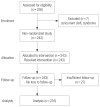Impact of orthognathic surgery on emotional expression and smile aesthetics in Chinese patients as measured by FaceReader: a before-and-after study
- PMID: 40624975
- PMCID: PMC12235305
- DOI: 10.7181/acfs.2025.0007
Impact of orthognathic surgery on emotional expression and smile aesthetics in Chinese patients as measured by FaceReader: a before-and-after study
Abstract
Background: The attractiveness of a person's smile is influenced by several factors, including gingival display, incisor show, and facial asymmetries. Malocclusion has long been recognized as having a significant negative impact on smile aesthetics. Addressing dentofacial deformities is a major treatment goal in orthodontic and orthognathic interventions, aiming to improve both functional and aesthetic outcomes. We sought to quantify and assess the impact of orthognathic surgery on a patient's expression of happiness within their smile, thereby addressing the current research gap in this highly subjective field.
Methods: We utilized FaceReader, a commercially available and previously validated artificial intelligence (AI) system, to analyze preoperative and postoperative facial photographs of 216 Chinese patients who underwent orthognathic surgery between January 1, 2021, and December 31, 2022. The AI software measures seven cardinal emotions and associated facial action units, providing an objective evaluation of emotional outcomes.
Results: Our findings indicated a significant postoperative increase in patients' expression of "happiness" while smiling, accompanied by a concurrent decrease in their estimated age. Patients with insufficient incisor show and open bite exhibited notable improvements in emotional expression, while those with a gummy smile showed no significant change. Additionally, stratification based on malocclusion classification (class I, II, III) revealed consistent improvements in emotional outcome scores among class II and III patients.
Conclusion: Our findings underscore the potential of AI in providing objective insights into emotional changes following orthognathic surgery.
Keywords: Artificial intelligence; Dental esthetics; Happiness; Orthognathic surgery; Smiling.
Conflict of interest statement
No potential conflict of interest relevant to this article was reported.
Figures





Similar articles
-
The Black Book of Psychotropic Dosing and Monitoring.Psychopharmacol Bull. 2024 Jul 8;54(3):8-59. Psychopharmacol Bull. 2024. PMID: 38993656 Free PMC article. Review.
-
Comparison of Two Modern Survival Prediction Tools, SORG-MLA and METSSS, in Patients With Symptomatic Long-bone Metastases Who Underwent Local Treatment With Surgery Followed by Radiotherapy and With Radiotherapy Alone.Clin Orthop Relat Res. 2024 Dec 1;482(12):2193-2208. doi: 10.1097/CORR.0000000000003185. Epub 2024 Jul 23. Clin Orthop Relat Res. 2024. PMID: 39051924
-
Automated 3D facial smile attractiveness assessment before and after orthognathic surgery using transfer learning: A preliminary study.J Plast Reconstr Aesthet Surg. 2025 Jul;106:193-202. doi: 10.1016/j.bjps.2025.05.010. Epub 2025 May 14. J Plast Reconstr Aesthet Surg. 2025. PMID: 40446608
-
Impact of residual disease as a prognostic factor for survival in women with advanced epithelial ovarian cancer after primary surgery.Cochrane Database Syst Rev. 2022 Sep 26;9(9):CD015048. doi: 10.1002/14651858.CD015048.pub2. Cochrane Database Syst Rev. 2022. PMID: 36161421 Free PMC article.
-
Do patients with malocclusion have a higher prevalence of temporomandibular disorders than controls both before and after orthognathic surgery? A systematic review and meta-analysis.J Craniomaxillofac Surg. 2017 Oct;45(10):1716-1723. doi: 10.1016/j.jcms.2017.07.015. Epub 2017 Jul 29. J Craniomaxillofac Surg. 2017. PMID: 28843406
References
-
- Reis GM, de Freitas DS, Oliveira RC, de Oliveira RC, Pinzan-Vercelino CR, Freitas KM, et al. Smile attractiveness in class III patients after orthodontic camouflage or orthognathic surgery. Clin Oral Investig. 2021;25:6791–7. - PubMed
-
- Isiksal E, Hazar S, Akyalcin S. Smile esthetics: perception and comparison of treated and untreated smiles. Am J Orthod Dentofacial Orthop. 2006;129:8–16. - PubMed
-
- Kim YJ, Lee BK. Recent trends in orthognathic surgery in Asia. Facial Plast Surg Clin North Am. 2021;29:549–66. - PubMed
-
- Bell R, Kiyak HA, Joondeph DR, McNeill RW, Wallen TR. Perceptions of facial profile and their influence on the decision to undergo orthognathic surgery. Am J Orthod. 1985;88:323–32. - PubMed
-
- Jesani A, DiBiase AT, Cobourne MT, Newton T. Perceived changes by peer group of social impact associated with combined orthodontic-surgical correction of class III malocclusion. J Dent. 2014;42:1135–42. - PubMed
LinkOut - more resources
Full Text Sources
Miscellaneous

